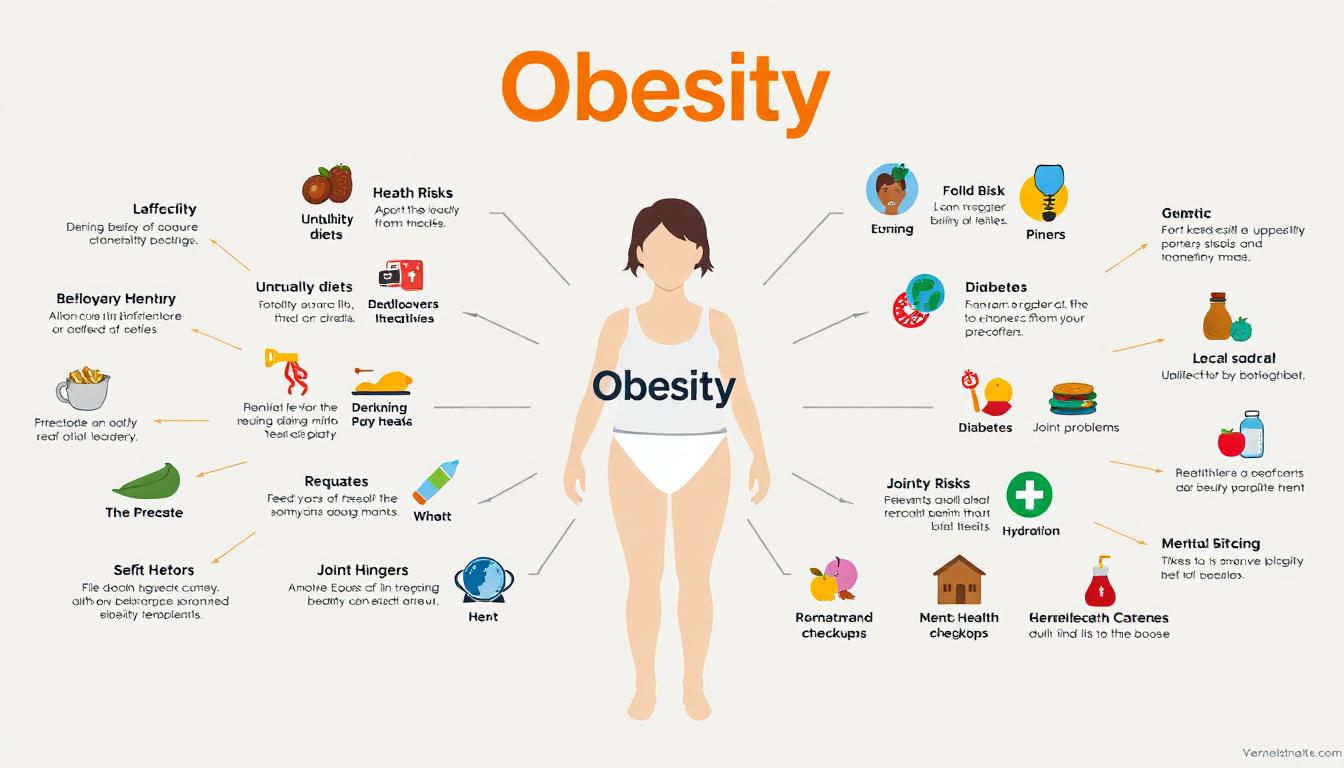Obesity isn’t merely about carrying extra weight; it’s a multifaceted health issue influenced by a tapestry of genetic, environmental, and lifestyle factors. Understanding the roots of obesity and its far-reaching impacts is crucial in crafting effective strategies for prevention and management.
Decoding the Roots of Obesity
1. Genetic Blueprint: The Inherited Predisposition
Genetics play a significant role in determining an individual’s susceptibility to obesity. Certain genes can influence appetite regulation, metabolism, and fat storage. For instance, variations in the FTO gene have been linked to increased hunger and caloric intake. However, possessing these genetic markers doesn’t seal one’s fate; lifestyle choices and environmental factors can modulate genetic risks.
2. Lifestyle Dynamics: The Modern-Day Conundrum
In today’s fast-paced world, convenience often trumps health. Sedentary lifestyles, characterized by prolonged sitting and minimal physical activity, coupled with the easy availability of calorie-dense, nutrient-poor foods, create a perfect storm for weight gain. The allure of fast food, sugary beverages, and processed snacks, combined with limited time for meal preparation, contributes significantly to the obesity epidemic.
3. Environmental Influences: The Surrounding Impact
Our environment profoundly shapes our behaviors and choices. Urban areas lacking safe spaces for physical activity, neighborhoods without access to fresh produce (often termed “food deserts”), and aggressive marketing of unhealthy foods all play a part in promoting obesity. Additionally, socioeconomic factors can limit access to health education and resources, further exacerbating the issue.
The Ripple Effects: Health Implications of Obesity
Obesity doesn’t exist in isolation; it sets the stage for a cascade of health complications that can diminish quality of life and increase mortality risk.
1. Cardiovascular Strain: The Heart Under Pressure
Excess body weight forces the heart to work harder, leading to elevated blood pressure and cholesterol levels. Over time, this strain can result in heart disease, heart attacks, and strokes. Studies have shown that obesity can accelerate the functional aging of the heart, making it appear decades older than its actual age .
2. Metabolic Disruptions: The Diabetes Connection
Obesity is a primary risk factor for type 2 diabetes. Excess fat, particularly visceral fat around the abdomen, can lead to insulin resistance, where the body’s cells become less responsive to insulin, resulting in elevated blood glucose levels. This condition not only increases the risk of diabetes but also its associated complications, such as neuropathy and kidney disease.
3. Musculoskeletal Challenges: The Joint Burden
Carrying extra weight places additional stress on joints, especially the knees and hips. This can accelerate the wear and tear of cartilage, leading to osteoarthritis. The pain and reduced mobility associated with joint issues can further discourage physical activity, creating a vicious cycle.
4. Oncological Risks: The Cancer Link
Obesity has been linked to an increased risk of several cancers, including breast, colon, endometrial, and kidney cancers. Fat tissue produces excess estrogen and other hormones that can promote the growth of certain cancer cells .
5. Respiratory Complications: The Breathing Struggle
Obstructive sleep apnea, a condition where breathing repeatedly stops and starts during sleep, is more prevalent among individuals with obesity. Excess fat around the neck can obstruct airways, leading to disrupted sleep and decreased oxygen levels, which can have cascading effects on overall health.
6. Psychological Impact: The Emotional Toll
Beyond physical health, obesity can take a significant emotional toll. Societal stigma, discrimination, and internalized negative self-perceptions can lead to depression, anxiety, and low self-esteem. Addressing the psychological aspects is crucial for holistic obesity management.
Charting a Course: Strategies for Prevention and Management
Tackling obesity requires a multifaceted approach that encompasses individual behavior changes, community support, and systemic interventions.
1. Nutritional Recalibration: Embracing Balanced Eating
Adopting a diet rich in whole foods—vegetables, fruits, lean proteins, whole grains, and healthy fats—can aid in weight management. Reducing the intake of processed foods, sugary beverages, and high-calorie snacks is equally important. Mindful eating practices, such as paying attention to hunger cues and avoiding emotional eating, can further support healthy eating habits.
2. Physical Activity: Moving Towards Health
Regular physical activity is a cornerstone of obesity prevention and management. Incorporating both aerobic exercises (like walking, cycling, or swimming) and strength training can enhance metabolism, build muscle mass, and improve overall health. Even small increments of activity, such as taking the stairs or short walks, can accumulate significant benefits over time.
3. Behavioral Interventions: Addressing Underlying Patterns
Behavioral therapy can help individuals identify and modify habits that contribute to weight gain. Techniques such as goal setting, self-monitoring, and problem-solving can empower individuals to make sustainable changes. Support groups and counseling can also provide motivation and accountability.
4. Medical and Surgical Options: When Necessary
For some individuals, especially those with severe obesity or obesity-related health conditions, medical interventions may be appropriate. Prescription medications can assist with appetite control and metabolism, while bariatric surgery may be considered for significant, sustained weight loss. These options should be discussed thoroughly with healthcare providers to weigh risks and benefits.
5. Community and Policy Initiatives: Creating Supportive Environments
Public health policies and community programs play a vital role in combating obesity. Initiatives such as implementing nutritional standards in schools, creating safe spaces for physical activity, and regulating food marketing can foster environments that support healthy choices.
Conclusion: A Collective Responsibility
Obesity is a complex, multifactorial issue that demands a comprehensive, compassionate approach. By understanding its underlying causes and implementing evidence-based strategies, individuals and societies can work towards mitigating its impact. Collaboration among individuals, healthcare providers, policymakers, and communities is essential in fostering a healthier future.


